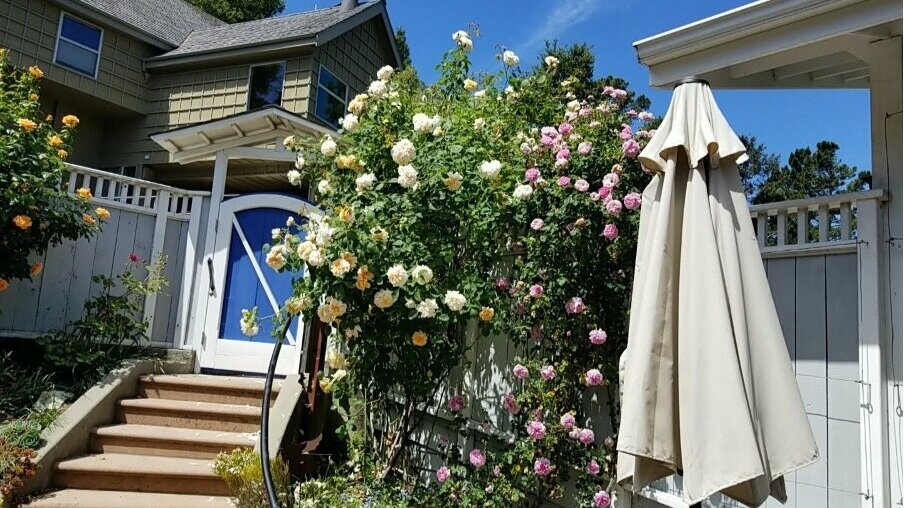Roses in June
Mine is the Month of Roses; yes, and mine
The Month of Marriages! All pleasant sights
And scents, the fragrance of the blossoming vine,
The foliage of the valleys and the heights.
Mine are the longest days, the loveliest nights;
The mower's scythe makes music to my ear;
I am the mother of all dear delights;
I am the fairest daughter of the year.
Longfellow: June from ‘The Poet’s Calendar’
It’s nearly the end of June, National Rose Month, and the roses in our garden have more or less finished blooming until the early autumn when some of them will burst into flower again.
The Bay Area is a marvellous area to grow roses. Most of the time, we have the perfect climate, although the fog off the ocean can create some problems for some more susceptible varieties. I love gardening here; everything seems to flourish and, as a Brit, I am always delighted to be able to grow our own limes & lemons, something I could never imagine back in the old country. As Sir Billy Conolly said: ‘In Scotland we have two seasons, June and Winter’.
I fully agree with Cicero who said that ‘If you have a garden and a library, you have everything you need.’ Of course, during this pandemic, I have been spending a good deal more time at home enjoying both. So, I would like to invite you into our garden and to tell you about a few of the roses that we have. But Richard Brinsley Sheridan said it much better than I:
“Won't you come into the garden? I would like my roses to see you.”
Ours in not a tidy garden. I am rather put off by the formality of an architectural garden where plants are lined up like soldiers on parade. I can’t stand topiary or the intricate designs of Baroque gardens which closely resemble the floor patterns of Menuets. It seems that in them nothing can actually be allowed to grow naturally. Instead, our roses tumble into each other, different varieties jostle with each other.
Here is a photo of our top garden with two David Austin roses, ‘Evelyn’ and ‘Charles Rennie MacIntosh’, jockeying for position.
Photo by N. McGegan
Some of our roses are named after composers and musicians. On a lower deck, pride of place goes to ‘Excellenz von Schubert’, a gorgeous hybrid musk rose, with clusters of deep pink flowers that bloom for much of the summer. Ours climbs up a pillar and cascades along a trellis.
We used to have a fine climbing rose called ‘Handel’ close by, but it wasn’t happy in that spot. We need to find a better place for it. The flowers are a beautiful mixture of pink and white, as if someone had lightly dipped the tips of white roses into a saucer of raspberry juice.
In our upper garden is one of our favourites: ‘Benjamin Britten’. This is a profusely flowering intense red rose, also by David Austin. As I write, the flowers are almost over, but I did cut a few to bring inside to put on our dining table. It has a rich fragrance which can perfume a whole room.
One of Britten’s most evocative pieces is his Nocturne op. 60 which contains a magical setting of a haunting poem by William Blake about a rose.
The Sick Rose — William Blake
O Rose, thou art sick:
The invisible worm,
That flies in the night In the howling storm,
Has found out thy bed
Of crimson joy;
And his dark secret love
Does thy life destroy.
Photo by N. McGegan
Many composers have set poetry about the fleeting nature of the flowers and how their delicate beauty contrasts with the sharpness of their thorns. Caroline Shaw’s setting of Burns’ poem ‘My love is like a red, red rose’ is one of many but perhaps one of the most magical. Composed for Anne Sofie von Otter it never fails to move all listeners.
The CD is on Spotify or can be bought.
‘Benjamin Britten’ is one of several Austin roses with musical names. There is also ‘Sir Edward Elgar’ and ‘Sir James Galway’. We have several named after Shakespearean characters, but if we could find space, we should certainly add one of these two. There is a terrific book about his roses written by Mr. Austin himself with Michael Marriott. The photography is superb.
Old varieties are generally so much nicer that the poor scentless specimens that are developed for bouquets. Of course, some varieties have all but disappeared over time. One of my favourite gardening books is In Search of Lost Roses by Thomas Christopher. He travels the globe to look for plants whose history is now obscured by time. Civil War graveyards and those of the Gold Rush miners in the Sierra Foothills are full of roses whose names are lost to us. Sometimes climbing roses have run riot and now ramble over buildings and up into the branches of trees. Each plant originally growing in memory of someone whose family wished to remember them in a distant place.
Roses, wonderful though they are in flower, can later in the year make the most wonderful jams and jellies. Here is a link to a recipe that I am longing to try.
Sadly, the flowers wilt and fade all too quickly but we were able in our Scottish flat to find a way of having roses bloom all year. In the back room, originally built to house a billiard table, we had a rose wallpaper designed by the remarkable Glasgow firm Timorous Beasties (which is named after a famous poem by Robert Burns ‘To a Mouse’).
Here is a photo of their gorgeous wallpaper called, I blush to say, The McGegan Rose. Here is a link to their website.
Photo by N. McGegan
Even if it is snowing outside, in this room it is June all year.




